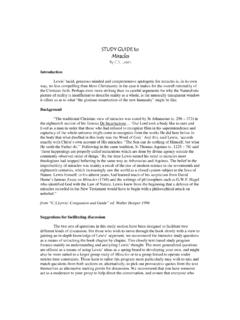Transcription of Germinal - Bottomless Studio
1 Germinal BY MILE ZOLA 1885 TRANSLATED BY HAVELOCK ELLIS 1894 Contents * Introduction by Havelock Ellis, 1894, from the Everyman's Library edition 1. PART 1 1. chapter 1 2. chapter 2 3. chapter 3 4. chapter 4 5. chapter 5 6. chapter 6 2. PART 2 1. chapter 1 2. chapter 2 3. chapter 3 4. chapter 4 5. chapter 5 3. PART 3 1. chapter 1 2. chapter 2 3. chapter 3 4. chapter 4 5. chapter 5 4. PART 4 1. chapter 1 2. chapter 2 3.
2 chapter 3 4. chapter 4 5. chapter 5 6. chapter 6 7. chapter 7 5. PART 5 1. chapter 1 2. chapter 2 3. chapter 3 4. chapter 4 5. chapter 5 6. chapter 6 6. PART 6 1. chapter 1 2. chapter 2 3. chapter 3 4. chapter 4 5. chapter 5 7. PART 7 1. chapter 1 2. chapter 22 3. chapter 3 4. chapter 4 5. chapter 5 6. chapter 6 NOTES We reprint the Vintage Classics paperback edition (ISBN 0-679-75430-X) with several spelling corrections.
3 We recommend, however, the translation by Stanley and Eleanor Hochman, in the Signet Classic paperback edition (ISBN 0-451-51975-2), because its English is more contemporary and in a few cases is closer to the vulgar French of the original. A Penguin Classics translation is also widely available. Any of these printed books would be easier to read than this online edition. The original text in French has been placed online in ATHENA in Switzerland. An excellent motion picture film has been adapted from this novel and is available on videotape from Sony Pictures Classics. It is rated R because of some nudity and profanity. It is in French, in letter-box format, with English subtitles. This Claude Berri film (copyright 1993) stars Gerard Depardieu, Renaud, Miou-Miou, Jean Carmet, Judith Henry, and Jean-Roger Milo.
4 It was made with the assistance of Region Nord/Pas-de-Calais, Ministere de la Culture et de la Francophone, of Centre Nationale de la Cinematographie, and of Ministere de l'Education Nationale, and supported by Funds Eurimages of the European Council. The film, although it is on two video cartridges, does improve on the book by leaving out many of the author's excesses of bad taste, although we are sorry to see it fails to show the spectacular, cinematic collapse of the mine toward the end of the book. While the working people in the film are treated sympathetically, Zola's treatment in the book veers back and forth, from seeing them as much animals as heroes. A study guide to the novel has been put online by Paul Brians, Department of English, Washington State University.
5 It has been said that this novel is one of confrontations, and the detail of the book makes this even plainer than the film. It is instructive to reflect on the political philosophy of early socialism and anarchism shown here. The concept of the "general strike" and the politicalization of labor strife are here apparent in a French historical context. Further, critics have remarked on the peculiarly French 19th-century social vice of envy rather than fraternity. While the film seems to romanticize somewhat the landscape in the style of some French rural painting, the book integrates better the French preoccupation with smells, sex, and food as necessary parts of life. In any case, this is one novel that seems to have escaped from the confines of Zola's aesthetic philosophy of positivism and determinism in fiction to achieve a romantic greatness of its own not so much appreciated at the time.
6 The word " Germinal " was used for a period after the French revolution of 1789 to refer to the calendar month corresponding to about March. Another point that may be confusing in the translation is the reference to ordinary people by their inflected last name: for example, "Moque" for the old man, "Moquet" for his son, and "Moquette" for his daughter. Toussaint Maheu's wife is thus called "Maheude" instead of "Mrs. Maheu" or "the Maheu woman." We'd like to be able to refer you to more about Zola on the World Wide Web, but it's just not there yet. A Zola home page seems to have disappeared from the web. Watch the Books-Online 3new listings page for additions to the corpus. Nana has recently been added to Project Gutenberg, as well as a few other, minor works in the public domain.
7 We'd as well like to provide some illustrations for this work, which seems to be stiflingly black and red. One rather famous one painted in a nearby region (but not France) is "The Potato Eaters" by Van Gogh-- (a Vincent Van Gogh biography is from Encarta) A friend and associate of Zola was the Swiss-born illustrator Th. A. Steinlen (1859-1923). 'The assault of Pas-de-Calais' is from Le Chambard Socialiste, December 16, 1893. (In the department of Pas-De-Calais in Northern France, 800 miners were fired.) 'The end of the strike' is from Assiette au beurre, May 9, 1901. (After a lost strike the workers have to face their employer again, their caps in their hands.) Both are from an exhibition in Amsterdam, National Trades Union Museum, October, 1997. A portrait of the author by Edouard Manet is reproduced and available for sale at Isabel Art Gallery.
8 There are many excellent and interesting photographs and engravings of the author. Here is one nice photo (130KB). The centenary of Zola's famous letter defending Captain Dreyfus and charging anti-Semitism passed without a great deal of commotion on the World Wide Web. Adam Estrup has contributed a fine essay on the Alfred Dreyfus affair detailing Zola's involvement. You may read the French text of the famous letter "J'Accuse", or in English translation. A transcript of a discussion of the letter, on the PBS Newshour with Jim Lehrer, January 13, 1998, may also be read HAVELOCK ELLIS' Germinal ' was published in 1885, after occupying Zola during the previous year. In accordance with his usual custom--but to a greater extent than with any other of his books except La D b cle--he accumulated material beforehand.
9 For six months he travelled about the coal-mining district in northern France and Belgium, especially the Borinage around Mons, note-book in hand. 'He was inquisitive, was that gentleman', miner told Sherard who visited the neighbourhood at a later period and found that the miners in every village knew Germinal . That was a tribute of admiration the book deserved, but it was never one of Zola's most popular novels; it was neither amusing enough nor outrageous enough to attract the Germinal occupies a place among Zola's works which is constantly becoming more assured, so that to some critics it even begins to seem the only book of his that in the end may survive. In his own time, as we know, the accredited critics of the day could find no condemnation severe enough for Zola.
10 Bruneti re attacked him perpetually with a fury that seemed inexhaustible; Sch rer could not even bear to hear his name mentioned; Anatole France, though he lived to relent, thought it would have been better if he had never been born. Even at that time, however, there were critics who inclined to view Germinal more favourably. Thus Faguet, who was the recognized academic critic of the end of the last century, while he held that posterity would be unable to understand how Zola could ever have been popular, yet recognized him as in Germinal the heroic representative of democracy, incomparable in his power of describing crowds, and he realized how marvellous is the conclusion of this , when critics view Zola In the main with indifference rather than with horror, although he still retains his popular favour, the distinction of Germinal is yet more clearly recognized.







